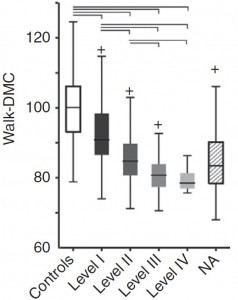Journal article accepted in Developmental Medicine & Child Neurology:
Kat Steele partnered with Mike Schwartz and Adam Rozumalski of Gillette Children’s Specialty Healthcare to complete one of the largest studies to date of individuals with cerebral palsy. They quantified how neuromuscular control is altered among individuals with cerebral palsy and how this altered control can contribute to impaired function.
Abstract: Individuals with cerebral palsy (CP) have impaired movement due to a brain injury near birth. Understanding how neuromuscular control is altered in CP can provide insight into pathological movement. We sought to determine if individuals with CP demonstrate reduced complexity of neuromuscular control during gait compared with unimpaired individuals and if changes in control are related to functional ability. Muscle synergies during gait were retrospectively analyzed for 633 individuals (age range 3.9–70y): 549 with CP (hemiplegia, n=122; diplegia, n=266; triplegia, n=73; quadriplegia, n=88) and 84 unimpaired individuals. Synergies were calculated using non-negative matrix factorization from surface electromyography collected during previous clinical gait analyses. Synergy complexity during gait was compared with diagnosis subtype, functional ability, and clinical examination measures. Fewer synergies were required to describe muscle activity during gait in individuals with CP compared with unimpaired individuals. Changes in synergies were related to functional impairment and clinical examination measures including selective motor control, strength, and spasticity. Interpretation: Individuals with CP use a simplified control strategy during gait compared with unimpaired individuals. These results were similar to synergies during walking among adult stroke survivors, suggesting similar neuromuscular control strategies between these clinical populations. PDF
Also, make sure you look at the commentary from Diane Damiano. She provides perspective about the utility of synergies for evaluating neuromuscular control in children with cerebral palsy and future challenges.

